How to Get Rid of Reef Pests
Reef pests can make your hobby really challenging. They can over run your tank quickly, attacking and killing costly corals and destroying years of healthy tank growth. The best way to treat Reef Pests is preventative measures, meaning you should always dip and quarantine any new corals before adding them to your main show tank. However, some pests can lie dormant in the egg stage thus circumventing even the best prophylactic measures. Today we'll take a look at the top 7 reef pests and tell you how to get rid of these unwanted tank invaders!
AIPTASIA ANEMONE:
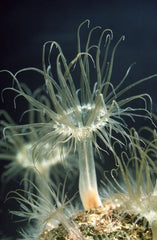 The most common and aggressive reef pest is the aiptasia anemone. These can enter your tank from almost anywhere, on live rock, on a coral frag or colony, even on a used piece of equipment. The aiptasia anemone will spread rapidly and can damage corals and sting fish. Agitating aiptasia can cause them to release eggs, thus increasing their growth in the tank. The best way to treat aiptasia is to take an aggressive approach. There are a variety of commercially available aiptasia treatments such as Red Sea Aiptasia-X or Blue Life's Aiptasia RX to name a few. All work very well and require frequent treatments. Another way to treat an aiptasia outbreak is to use an aiptasia wand to zap it with electricity until it implodes, or you can use a high power blue laser to burn the tentacles off the anemone so that it cannot feed, thus causing starvation. If you have a coral saw, remove the rock from the tank and cut the affected area off the rock. Additionally you can use natural predators to attack aiptasia such as the Copperband Butterfly Fish, Peppermint Shrimp or Berghia Nudibranchs. You may wish to employ several or all of the techniques listed above when treating an aiptasia outbreak. Be aggressive and relentless or this little pest will over run you tank in no time.
The most common and aggressive reef pest is the aiptasia anemone. These can enter your tank from almost anywhere, on live rock, on a coral frag or colony, even on a used piece of equipment. The aiptasia anemone will spread rapidly and can damage corals and sting fish. Agitating aiptasia can cause them to release eggs, thus increasing their growth in the tank. The best way to treat aiptasia is to take an aggressive approach. There are a variety of commercially available aiptasia treatments such as Red Sea Aiptasia-X or Blue Life's Aiptasia RX to name a few. All work very well and require frequent treatments. Another way to treat an aiptasia outbreak is to use an aiptasia wand to zap it with electricity until it implodes, or you can use a high power blue laser to burn the tentacles off the anemone so that it cannot feed, thus causing starvation. If you have a coral saw, remove the rock from the tank and cut the affected area off the rock. Additionally you can use natural predators to attack aiptasia such as the Copperband Butterfly Fish, Peppermint Shrimp or Berghia Nudibranchs. You may wish to employ several or all of the techniques listed above when treating an aiptasia outbreak. Be aggressive and relentless or this little pest will over run you tank in no time.
MAJANO ANEMONE: Majano anemones are deceptive to beginner reef keepers because they look like cute little green anemones. Do not be fooled by their charming appearance. Like aiptasia, these pests can spread very quickly and take over your tank if left untreated, and they will sting and kill surrounding corals. Luckily, Majano Anemones are easier to treat than aiptasia because they are less resiliant, slightly larger, easier to spot, and easier to treat. Most aiptasia injections work very well on Majanos, as does the Majano Wand method of electrocuting it until it implodes.
Majano anemones are deceptive to beginner reef keepers because they look like cute little green anemones. Do not be fooled by their charming appearance. Like aiptasia, these pests can spread very quickly and take over your tank if left untreated, and they will sting and kill surrounding corals. Luckily, Majano Anemones are easier to treat than aiptasia because they are less resiliant, slightly larger, easier to spot, and easier to treat. Most aiptasia injections work very well on Majanos, as does the Majano Wand method of electrocuting it until it implodes.
BRISTLE WORMS: Bristle Worms can actually be beneficial live rock inhabitants and sand sifters, until the population gets out of control, or they grow to be 5 inches or longer. Then they can pose a threat to your tank by attacking corals, invertebrates and even fish. The best way to get rid of bristle worms is to physically remove them. For larger worms, there are bristle worm traps available. If you intend to remove bristle worms by hand, always use gloves as you may be unwittingly grabbing a fire worm, which could result in a painful trip to the emergency room.
Bristle Worms can actually be beneficial live rock inhabitants and sand sifters, until the population gets out of control, or they grow to be 5 inches or longer. Then they can pose a threat to your tank by attacking corals, invertebrates and even fish. The best way to get rid of bristle worms is to physically remove them. For larger worms, there are bristle worm traps available. If you intend to remove bristle worms by hand, always use gloves as you may be unwittingly grabbing a fire worm, which could result in a painful trip to the emergency room.
CORAL EATING NUDIBRANCHS: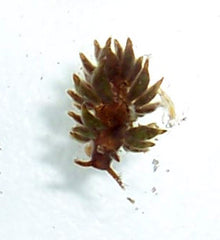 Coral eating nudibranchs can very difficult to spot because of their size and the fact that they are masters of camouflage, often taking on the colors and characteristics of the coral they are attacking. They can reproduce quickly and decimate a coral colony just as fast. Coral eating nudibranchs can be treated by dipping the affected corals or by removing them with a small plastic pipette. The eggs are untreatable with coral dips, so be sure to dip the affected corals once or twice per week for about 4-6 weeks until all new nudibranchs have been eliminated.
Coral eating nudibranchs can very difficult to spot because of their size and the fact that they are masters of camouflage, often taking on the colors and characteristics of the coral they are attacking. They can reproduce quickly and decimate a coral colony just as fast. Coral eating nudibranchs can be treated by dipping the affected corals or by removing them with a small plastic pipette. The eggs are untreatable with coral dips, so be sure to dip the affected corals once or twice per week for about 4-6 weeks until all new nudibranchs have been eliminated.
BROWN FLATWORMS (Planaria):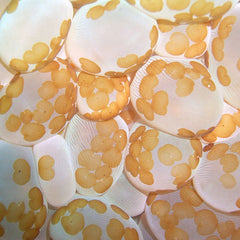 Planaria are very common in aquariums, however if left untreated they can quickly become a nuisance. Typically these are found in aquariums with a lot of waste accumulated as a result of poor tank maintenance. Brown flatworms will sit on your corals and block out the light, thus preventing photosynthesis in your corals. Planaria can be treated with medications such as Blue Life Flatworm RX, or you can use natural predators such as Dragonettes or Wrasses.
Planaria are very common in aquariums, however if left untreated they can quickly become a nuisance. Typically these are found in aquariums with a lot of waste accumulated as a result of poor tank maintenance. Brown flatworms will sit on your corals and block out the light, thus preventing photosynthesis in your corals. Planaria can be treated with medications such as Blue Life Flatworm RX, or you can use natural predators such as Dragonettes or Wrasses.
ACROPORA EATING FLATWORMS: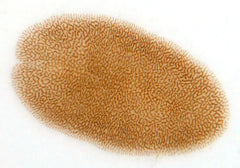 Unlike Brown Flatworms, Acropora Eating Flatworms (AEFW) WILL actually eat your acropora corals. If left untreated, they can rapidly decimate your SPS corals. The best way to treat AEFW is to use a triple approach. Chemical dips, natural predators and physically removing them from your corals.
Unlike Brown Flatworms, Acropora Eating Flatworms (AEFW) WILL actually eat your acropora corals. If left untreated, they can rapidly decimate your SPS corals. The best way to treat AEFW is to use a triple approach. Chemical dips, natural predators and physically removing them from your corals.
RED BUGS: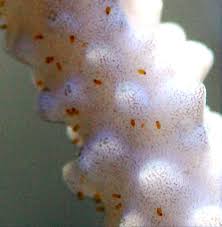 These small crustaceans will feed on your Acropora corals, and in large numbers can destroy a coral colony. Harder to spot and remove than AEFW, the best way to treat Red Bugs is a combination of dipping and physically removing them with tweezers or small tongs. Certain Pipefish do prey on red bugs, however they can be picky eaters and are difficult to keep in an aquarium.
These small crustaceans will feed on your Acropora corals, and in large numbers can destroy a coral colony. Harder to spot and remove than AEFW, the best way to treat Red Bugs is a combination of dipping and physically removing them with tweezers or small tongs. Certain Pipefish do prey on red bugs, however they can be picky eaters and are difficult to keep in an aquarium.
ASTERINA STARFISH: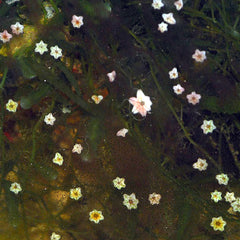 Asterina Starfish are tiny, micro stars that can overrun your tank very quickly if left untreated. They are typically introduced to a tank by hitchhiking on live rock. Asterina Stars are about 0.25 inch to 1 inch in size and reproduce quickly by fragmentation. The best way to treat a tank overrun with Asterina Stars is to physically remove them from your tank using tweezers or small tongs. If you have a substantial population of Asterina stars, you may want to consider getting a Harlequin Shrimp as they are natural predators of Asterinas, however be sure you have enough stars to sustain the voracious appetite of the Harlequin Shrimp, or you will quickly run out and your shrimp will die.
Asterina Starfish are tiny, micro stars that can overrun your tank very quickly if left untreated. They are typically introduced to a tank by hitchhiking on live rock. Asterina Stars are about 0.25 inch to 1 inch in size and reproduce quickly by fragmentation. The best way to treat a tank overrun with Asterina Stars is to physically remove them from your tank using tweezers or small tongs. If you have a substantial population of Asterina stars, you may want to consider getting a Harlequin Shrimp as they are natural predators of Asterinas, however be sure you have enough stars to sustain the voracious appetite of the Harlequin Shrimp, or you will quickly run out and your shrimp will die.
